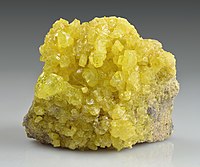
Photo from wikipedia
Expanding interspace and introducing vacancies are desired to promote the mobility of Zn ions and unlock the inactive sites of layered cathodes. However, this two‐point modulation has not yet been… Click to show full abstract
Expanding interspace and introducing vacancies are desired to promote the mobility of Zn ions and unlock the inactive sites of layered cathodes. However, this two‐point modulation has not yet been achieved simultaneously in vanadium phosphate. Here, a strategy is proposed for fabricating an alcohol‐based organic–inorganic hybrid material, VO1−xPO4·0.56C6H14O4, to realize the conjoint modulation of the d‐interspace and oxygen vacancies. Peculiar triglycol molecules with an inclined orientation in the interlayer also boost the improvement in the conversion rate of V5+ to V4+ and the intensity of the PO bond. Their synergism can ensure steerable adjustment for intercalation kinetics and electron transport, as well as realize high chemical reactivity and redox‐center optimization, leading to at least 200% increase in capacity. Using a water–organic electrolyte, the designed Zn‐ion batteries with an ultrahigh‐rate profile deliver a long‐term durability (fivefold greater than pristine material) and an excellent energy density of ≈142 Wh kg−1 (including masses of cathode and anode), thereby substantially outstripping most of the recently reported state‐of‐the‐art zinc‐ion batteries. This work proves the feasibility to realize the two‐point modulation by using organic intercalants for exploiting high‐performance new 2D materials.
Journal Title: Advanced Materials
Year Published: 2022
Link to full text (if available)
Share on Social Media: Sign Up to like & get
recommendations!